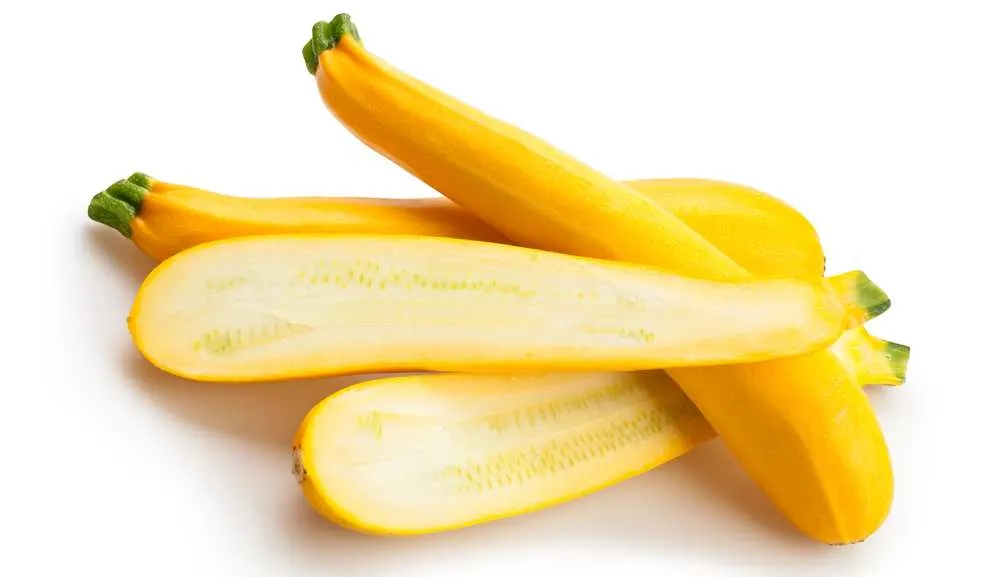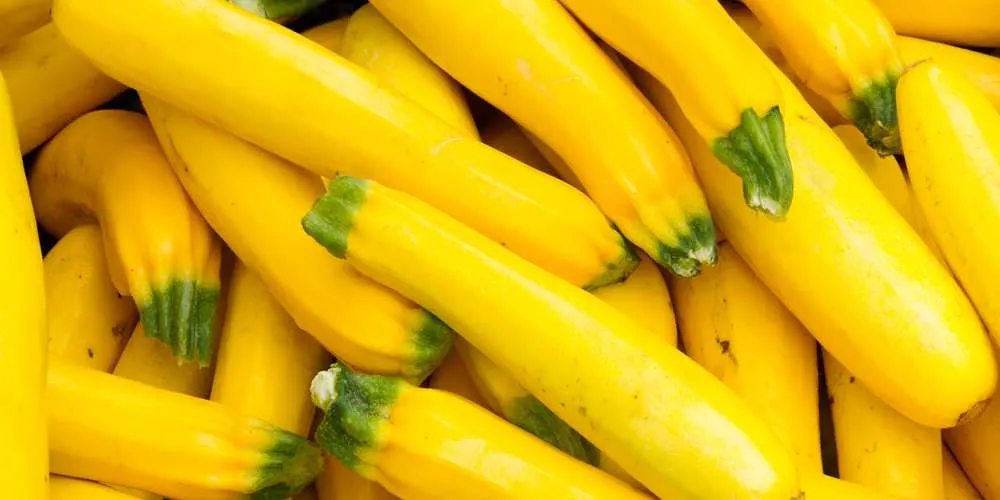What better time to talk about summer vegetables than winter?
Today we’re talking about zucchini’s yellow cousin, the yellow squash, and whether our furry friends can enjoy it with us. We’ll cover what yellow squash exactly, how it differs from other squashes, and what are its main benefits.
More importantly, we’ll see if it’s the best thing for our pups. Oh, and if you’re interested if dogs can eat zucchini, we have an article on that as well.
So, enough foreplay, let’s tackle – can dogs eat yellow squash.

Can Dogs Eat Yellow Squash?
Your el perro (that’s a word for dog in Spanish) may enjoy yellow squash. But, before you start throwing squash at your dog’s feet right in the produce section, you might want to read through this entire article.
Most things in life come with a few caveats, surprisingly enough, feeding your dog yellow squash is also one of those things.
To understand better how squash and dogs go together, let’s learn a thing or two about the yellow squash itself.
A Thing Or Two About Yellow Squash
Yellow squash is a summer vegetable. When in season, you can find it pretty much anywhere.
It’s different from zucchini not just because of its color but also its shape. Even though it tastes similar to zucchini, it’s not nearly as popular. Why that is, we don’t know. Maybe it’s the exotic name.
But when it comes to nutrition, yellow squash is no slouch.
Cooked Yellow Squash (100g)
| Calories | 16 |
| Total Fat | 0.2 g 0% |
| Saturated Fat | 0 g 0% |
| Polyunsaturated Fat | 0.1 g |
| Monounsaturated Fat | 0 g |
| Cholesterol | 0 mg 0% |
| Sodium | 2 mg 0% |
| Potassium | 262 mg 7% |
| Total Carbohydrate | 3.4 g 1% |
| Dietary Fiber | 1.1 g 4% |
| Sugar | 2.2 g |
| Protein | 1.2 g 2% |
| Vitamin A | 4% |
| Vitamin C | 28% |
| Calcium | 1% |
| Iron | 2% |
| Vitamin D | 0% |
| Vitamin B-6 | 10% |
| Cobalamin | 0% |
| Magnesium | 4% |
Benefits That Yellow Squash Provides
1. A Touch Overweight
First of all, for all those who want to eat fewer calories throughout the day, yellow squash is phenomenal. Only 16 calories in 100 grams, that’s some pretty powerful stuff.
With its strong fiber content, yellow squash is a great option for anyone who wants to lose some weight. If your dog is obese, yellow squash can be a great addition to its diet.
Since it’s so dense but low in calories, it will keep your dog fuller longer without adding any excess weight.
2. No More Bacon
Zero cholesterol will have any middle-aged housewife drown their husband in this vegetable.
However, believe it or not, dogs can also suffer from high cholesterol. This makes yellow squash an even more appealing option, not just for you but for your pup as well.
The fact that besides low cholesterol, it also has a low-calorie count, I don’t know why you’re not planting a few in your garden already.
3. Electrocuted
Next, we have potassium. Potassium is an electrolyte that is essential for your body to function properly. You need a daily intake of it since your body doesn’t produce it on its own.Potassium is responsible for your blood pressure, digestion, heart rhythm, just to name a few.
Both us and dogs can suffer from either potassium deficiency or an unwanted surplus. Since it plays such a vital role, making sure your dog ( or loved one) has enough potassium in a regular diet is a must. You definitely don’t need an electrolyte imbalance occurring.
Food that is rich in potassium includes bananas, spinach, mushrooms, tuna, halibut, potatoes, cucumbers, lentils, etc.
4. Whose A Big Boy
Vitamin B-6 is also an essential ingredient for a healthy functioning body. Just like potassium, our bodies don’t produce it. So it would be best if you watched your daily intake of it. It’s a big part of your metabolism, and it also plays a role in red blood cell production and neurotransmitters.
Vitamin B-6 helps dogs properly absorb protein and is essential for younger pups who are still in development. Adding to that, it will keep your dog’s heart healthy and beating for a while.
5. Homemade
Finally, we have vitamin C. There’s no denying vitamin C is one of the more popular vitamins and for a good reason. It boosts our immune system, protects us from cardiovascular diseases, eye deterioration, and keeps our skin healthy.
However, dogs make their own vitamin C. So the fact that yellow squash is so packed with it isn’t that big of a factor when it comes to dogs.

How To Serve Yellow Squash
The three most important things to keep in mind is :
- Remove the seeds
- Remove the skin
- Cook it
Stick to the meat of the squash. Everything else can be harmful to dogs. So, you’ve cooked it and either cut it to pieces or made a puree out of it, but your furball just gave it a whiff and went back to sleep.
Even though we said that it has many benefits, that doesn’t mean your dog will automatically want to eat the squash. Just like you hated fruit when you were a kid but couldn’t get enough milk duds, well, this time, your dog is the kid. One of the surest ways to make sure he/she eats the squash is to serve it with meat.
Speaking of squash, a winter kind this time, we have an article on butternut squash as well. Click right here to find out can dogs eat butternut squash?
Things To Watch Out For
Letting your dog have too much squash for the first time is not ideal.
Dogs can be allergic to food, just like us. Starting with small portions and monitoring their behavior is strongly recommended.
Fiber is a double-edged sword. Not having enough can cause problems but also having too much. Suppose your pup is showing any signs of discomfort and starts suffering from diarrhea or gases. In that case, you might be serving too much squash, or it’s not a good option for him/her in the first place.
Finally, if your dog had some raw yellow squash and ate the whole thing, you might want to consider taking it to a vet. If that scenario actually happens, you’re probably not feeding your dog regularly or properly. Not a good way to treat the man’s best friend.
Be that as it may, seeds and skin of yellow squash can cause various digestive issues, so please be responsible.

Conclusion
By examining all the evidence (ample evidence), we’ve come to the conclusion that canine species can indeed enjoy some yellow squash. In fact, we’ve said so many good things about yellow squash, I’m afraid people will think it’s the only food their dogs need.
But that’s not the case. Yes, it’s great for their stomach, their growth, their brains, etc. If you have a dog that is suffering from diabetes or high cholesterol, yellow squash might be the option for him.
However, having a balanced diet is a must. Remember to start small. See how your pet likes it and how it reacts to it. Masking it in some meat is a good way to introduce this vegetable.
Always remove the skin and seeds, and make sure to cook it properly. If your dog accidentally ate some raw yellow squash, skin, and seeds included, maybe get them to a vet, better safe than sorry.
Other than that, making this vegetable a daily part of your and your dog’s diet wouldn’t be the worst decision you’ve ever made.
Learn More: What Can Dogs Eat? A Comprehensive List Of Dog-safe Foods

